Land Degradation Neutrality: State and Trend of Degradation at the Subnational Level in Mexico
Abstract
1. Introduction
2. Materials and Methods
2.1. Study Site
2.2. Data Sources
2.3. Detection and Analysis of Land Cover Changes
2.4. Determination of Land Productivity Dynamics
2.5. Soil Organic Carbon (SOC) Stocks Assessment
2.6. Land Degradation State
2.7. Statistical Analysis
3. Results
3.1. Land Cover
3.2. Land Productivity Dynamics
3.3. Soil Organic Carbon
3.4. Land Degradation State
4. Discussion
4.1. Land Cover Degradation
4.2. Land Productivity Dynamics Degradation
4.3. Soil Organic Carbon Degradation
4.4. Land Degradation Neutrality
5. Conclusions
Author Contributions
Funding
Institutional Review Board Statement
Informed Consent Statement
Data Availability Statement
Acknowledgments
Conflicts of Interest
References
- UNCCD. Land Degradation Neutrality Target Setting—A Technical Guide; The Global Mechanism: Bonn, Germany, 2016. [Google Scholar]
- MEA. Ecosystems and Human Well-Being; Island Press/Center for Resource Economics: Washington, DC, USA, 2005.
- Grainger, A. Is Land Degradation Neutrality feasible in dry areas? J. Arid Environ. 2015, 112, 14–24. [Google Scholar] [CrossRef]
- Al Sayah, M.J.; Abdallah, C.; Khouri, M.; Nedjai, R.; Darwich, T. Application of the LDN concept for quantification of the impact of land use and land cover changes on Mediterranean watersheds—Al Awali basin—Lebanon as a case study. Catena 2019, 176, 264–278. [Google Scholar] [CrossRef]
- Baskan, O.; Dengiz, O.; Demirag, İ.T. The land productivity dynamics trend as a tool for land degradation assessment in a dryland ecosystem. Environ. Monit. Assess. 2017, 189, 212. [Google Scholar] [CrossRef] [PubMed]
- Sommer, S.; Zucca, C.; Grainger, A.; Cherlet, M.; Zougmore, R.; Sokona, Y.; Hill, J.; Della Peruta, R.; Roehrig, J.; Wang, G. Application of indicator systems for monitoring and assessment of desertification from national to global scales. Land Degrad. Dev. 2011, 22, 184–197. [Google Scholar] [CrossRef]
- Pacheco, F.A.L.; Sanches Fernandes, L.F.; Valle Junior, R.F.; Valera, C.A.; Pissarra, T.C.T. Land degradation: Multiple environmental consequences and routes to neutrality. Curr. Opin. Environ. Sci. Health 2018, 5, 79–86. [Google Scholar] [CrossRef]
- Oldeman, L.R.; Hakkeling, R.T.; Sombroek, W.G. World Map of the Status of Human-Induced Soil Degradation, Global Assessment of Soil Degradation (GLASOD), 2nd ed.; ISRIC: Wageningen, The Netherlands, 1991. [Google Scholar]
- FAO. Land Degradation Assessment in Drylands (LADA); Food and Agriculture Organization of the United Nations: Rome, Italy, 2002. [Google Scholar]
- Bai, Z.G.; Dent, D.L.; Olsson, L.; Schaepman, M.E. Global Assessment of Land Degradation and Improvement: 1. Identification by Remote Sensing; ISRIC—World Soil Information: Wageningen, The Netherlands, 2008. [Google Scholar]
- SEMARNAT-CP. Evaluación De La Degradación Del Suelo Causada Por El Hombre En La República Mexicana; Secretaria de Medio Ambiente y Recursos Naturales; Colegio de Postgraduados: Montecillo, Mexico, 2002. [Google Scholar]
- CONAFOR-UACh. Línea Base Nacional De Degradación De Tierras Y Desertificación. Informe Final.; Comision Nacional Forestal-Universidad Autonoma de Chapingo: Zapopan, Jalisco, Mexico, 2013. [Google Scholar]
- Del Barrio, G.; Sanjuan, M.E.; Hirche, A.; Yassin, M.; Ruiz, A.; Ouessar, M.; Valderrama, J.M.; Essifi, B.; Puigdefabregas, J. Land degradation states and trends in the northwestern Maghreb drylands, 1998–2008. Remote Sens. 2016, 8, 603. [Google Scholar] [CrossRef]
- Van Lynden, G.W.; Oldeman, L.R. The Assment of the Status of Human-Induced Soil Degradation in South and Southeast Asia; ISRIC: Wageningen, The Netherlands, 1997. [Google Scholar]
- Pulido, J.; Bocco, G. How is land degradation assessed ? A global and local overview. Interciencia 2016, 36, 96–103. [Google Scholar]
- Gibbs, H.K.; Salmon, J.M. Mapping the world’s degraded lands. Appl. Geogr. 2015, 57, 12–21. [Google Scholar] [CrossRef]
- Nachtergaele, F.; Biancalani, R. Land Degradation Assessment: The LADA Approach. In Proceedings of the 19th World Congress of Soil Science, Brisbane, Australia, 1–6 August 2010; pp. 72–75. [Google Scholar]
- Gichenje, H.; Godinho, S. Establishing a land degradation neutrality national baseline through trend analysis of GIMMS NDVI Time-series. Land Degrad. Dev. 2018, 29, 2985–2997. [Google Scholar] [CrossRef]
- UNCCD. Default Data: Methods and Interpretation a Guidance Document for 2018 UNCCD Reporting; United Nations Convention to Combat Desertification: Bonn, Germany, 2018. [Google Scholar]
- Cowie, A.L.; Orr, B.J.; Castillo Sanchez, V.M.; Chasek, P.; Crossman, N.D.; Erlewein, A.; Louwagie, G.; Maron, M.; Metternicht, G.I.; Minelli, S.; et al. Land in balance: The scientific conceptual framework for Land Degradation Neutrality. Environ. Sci. Policy 2018, 79, 25–35. [Google Scholar] [CrossRef]
- Chasek, P.; Akhtar-Schuster, M.; Orr, B.J.; Luise, A.; Rakoto Ratsimba, H.; Safriel, U. Land degradation neutrality: The science-policy interface from the UNCCD to national implementation. Environ. Sci. Policy 2019, 92, 182–190. [Google Scholar] [CrossRef]
- Sims, N.C.; Green, C.; Newnham, G.J.; England, J.R.; Held, A.; Wulder, M.A.; Herold, M.; Cox, S.J.D.; Huete, A.R.; Kumar, L.; et al. Good Practice Guidance: SDG Indicator 15.3.1. Version 1.0; United Nations Convention to Combat Desertification: Bonn, Germany, 2017. [Google Scholar]
- Chasek, P.; Safriel, U.; Shikongo, S.; Fuhrman, V.F. Operationalizing Zero Net Land Degradation: The next stage in international efforts to combat desertification? J. Arid. Environ. 2015, 112, 5–13. [Google Scholar] [CrossRef]
- Stavi, I.; Lal, R. Achieving Zero Net Land Degradation: Challenges and opportunities. J. Arid Environ. 2015, 112, 44–51. [Google Scholar] [CrossRef]
- Akhtar-Schuster, M.; Stringer, L.C.; Erlewein, A.; Metternicht, G.; Minelli, S.; Safriel, U.; Sommer, S. Unpacking the concept of land degradation neutrality and addressing its operation through the Rio Conventions. J. Environ. Manag. 2017, 195, 4–15. [Google Scholar] [CrossRef]
- López-Santos, A. Neutralizar la degradación de las tierras, una aspiración global. ¿Es posible lograrlo en Mexico? Terra Latinoam. 2016, 34, 239–249. [Google Scholar]
- Kust, G.; Andreeva, O.; Cowie, A. Land Degradation Neutrality: Concept development, practical applications and assessment. J. Environ. Manag. 2017, 195, 16–24. [Google Scholar] [CrossRef]
- Akinyemi, F.O.; Ghazaryan, G.; Dubovyk, O. Assessing UN indicators of land degradation neutrality and proportion of degraded land for Botswana using remote sensing based national level metrics. Land Degrad. Dev. 2021, 32, 158–172. [Google Scholar] [CrossRef]
- Wunder, S.; Bodle, R. Achieving land degradation neutrality in Germany: Implementation process and design of a land use change based indicator. Environ. Sci. Policy 2019, 92, 46–55. [Google Scholar] [CrossRef]
- Willemen, L.; Crossman, N.D.; Quatrini, S.; Egoh, B.; Kalaba, F.K.; Mbilinyi, B.; de Groot, R. Identifying ecosystem service hotspots for targeting land degradation neutrality investments in south-eastern Africa. J. Arid Environ. 2018, 159, 75–86. [Google Scholar] [CrossRef]
- Kapović, M.; Barger, N.; Cerda, A.; Keesstra, S.; Marković, M. Assessing land condition as a first step to achieving land degradation neutrality: A case study of the Republic of Srpska. Environ. Sci. Policy 2018, 90, 19–27. [Google Scholar] [CrossRef]
- Kiani-harchegani, M.; Hamidreza, S. Practicing land degradation neutrality (LDN) approach in the Shazand Watershed, Iran. Sci. Total Environ. 2020, 698, 134319. [Google Scholar] [CrossRef] [PubMed]
- Nijbroek, R.; Piikki, K.; Söderström, M.; Kempen, B.; Turner, K.G.; Hengari, S.; Mutua, J. Soil organic carbon baselines for land degradation neutrality: Map accuracy and cost tradeoffs with respect to complexity in Otjozondjupa, Namibia. Sustainability 2018, 10, 1610. [Google Scholar] [CrossRef]
- Vågen, T.G.; Ann Winowiecki, L.; Neely, C.; Chesterman, S.; Bourne, M. Spatial assessments of soil organic carbon for stakeholder decision-making—A case study from Kenya. Soil 2018, 4, 259–266. [Google Scholar] [CrossRef]
- Peralta-Carreta, C.; Gallardo-Cruz, J.A.; Solórzano, J.V.; Hernández-Gómez, M. Classification of land use and vegetation in tree cover loss areas (2000-2016) in the Usumacinta river watershed. Madera Y Bosques 2019, 25, 1–19. [Google Scholar] [CrossRef]
- UNCCD. Land Degradation Neutrality Resilience at Local, National and Regional Levels; United Nations Convention to Combat Desertification: Bonn, Germany, 2015. [Google Scholar]
- INEGI. Prontuario De Información Geográfica Municipal De Los Estados Unidos Mexicanos Ixtacamaxtitlán, Puebla; INEGI: Puebla, Mexico, 2009. [Google Scholar]
- SEDESOL. Atlas De Riesgos Naturales Del Municipio De Ixtacamaxtitlán, Puebla; Secretaria de Desarrollo Social: Ixtacamaxtitlan, Puebla, Mexico, 2012. [Google Scholar]
- EIDH. Minería Canadiense En Puebla Y Su Impacto En Los Derechos Humanos: Por La Vida Y El Futuro De Ixtacamaxtitlán Y La Cuenca Del Río Apulco; Evaluación de Impacto en Derechos Humanos: Ixtacamaxtitlan, Puebla, Mexico, 2017. [Google Scholar]
- Bastidas-Orrego, L.M.; Ramírez-Valverde, B.; Cesín-Vargas, A.; Juárez-Sánchez, J.P.; Martínez-Carrera, D.; Vaquera-Huerta, H. Socioenvironmental Conflicts and Open-Pit Mining in the Sierra Norte De Puebla, Mexico. Textual 2019, 72, 35–66. [Google Scholar] [CrossRef]
- Humphreys-Bebbington, D.; Sauls, L. Evaluación Y Alcance De La Relación De Las Industrias Extractivas Y La Infraestructura Con La Deforestación: Mexico; Climate and Land Use Alliance: San Francisco, CA, USA, 2019. [Google Scholar]
- SEDESOL. Informe Anual Sobre La Situación De Pobreza Y Rezago Social, Ixtacamaxtitlán, Puebla; Secretaria de Desarrollo Social: Ixtacamaxtitlan, Puebla, Mexico, 2017. [Google Scholar]
- INEGI. Síntesis Geográfica Del Estado De Puebla; INEGI: Puebla, Mexico, 2000. [Google Scholar]
- SEMARNAT-CONAFOR. Inventario Estatal Forestal Y De Suelos: Puebla; Secretaría de Medio Ambiente y Recursos Naturales: Puebla, Mexico, 2013. [Google Scholar]
- ESA. European Space Agency—Climate Change Initiative—Land Cover. Available online: http://maps.elie.ucl.ac.be/CCI/viewer/index.php (accessed on 25 September 2021).
- Didan, K.; Munoz, A.B.; Solano, R.; Huete, A. MODIS Vegetation Index User ’s Guide; Version 3; The University of Arizona: Tucson, AZ, USA, 2015. [Google Scholar]
- CONAF. Reporte De Neutralidad En La Degradación De Las Tierras (NDT) Ante La Convención De Las Naciones Unidas De Lucha Contra la Desertificación (CNULD); Corporación Nacional Forestal: Santiago de Chile, Chile, 2017. [Google Scholar]
- Hengl, T.; De Jesus, J.M.; Heuvelink, G.B.M.; Gonzalez, M.R.; Kilibarda, M.; Blagotić, A.; Shangguan, W.; Wright, M.N.; Geng, X.; Bauer-Marschallinger, B.; et al. SoilGrids250m: Global Gridded Soil Information Based on Machine Learning. PLoS ONE. 2017, 12, 1–40. [Google Scholar] [CrossRef]
- Di Gregorio, A.; Jansen, L. Land Cover Classification System (LCCS): Classification Concepts and User Manual; Food and Agriculture Organization of the United Nations: Rome, Italy, 1998; Volume 53. [Google Scholar]
- Bickel, K.; Richards, G.; Köhl, M.; Vianna, R. Consistent Representation of Lands. In Guidelines for National Greenhouse Gas Inventories; IPCC: Wageningen, The Netherlands, 2006; p. 42. [Google Scholar]
- Pontius, R.G.; Shusas, E.; McEachern, M. Detecting important categorical land changes while accounting for persistence. Agric. Ecosyst. Environ. 2004, 101, 251–268. [Google Scholar] [CrossRef]
- Orr, B.; Cowie, A.; Castillo, V.; Chasek, P.; Crossmas, N.; Erlewein, A.; Louwagie, G.; Maron, M.; Metternicht, G.; Minelli, S.; et al. Scientific Conceptual Framework for Land Degradation Neutrality. A Report of the Science-Policy Interface; UNCCD: Bonn, Germany, 2017. [Google Scholar]
- Dogan, M. Tokat ili bitki yoğunluk sınıflarının LANDSAT-7 ETM+ uydu görüntüleri ve Coğrafi Bilgi Sistemleri ile araştırılması. J. Agric. Fac. Gaziosmanpasa Univ. 2014, 31, 47. [Google Scholar] [CrossRef]
- Mitri, G.; Nasrallah, G.; Gebrael, K.; Bou Nassar, M.; Abou Dagher, M.; Nader, M.; Masri, N.; Choueiter, D. Assessing land degradation and identifying potential sustainable land management practices at the subnational level in Lebanon. Environ. Monit. Assess. 2019, 191, 1–22. [Google Scholar] [CrossRef]
- Conservation International. Trends Earth Documentation. Realease 1.0.2; Conservation International: Arlington, VA, USA, 2020. [Google Scholar]
- Sims, N.C.; Barger, N.N.; Metternicht, G.I.; England, J.R. A land degradation interpretation matrix for reporting on UN SDG indicator 15. 3.1 and land degradation neutrality. Environ. Sci. Policy 2020, 114, 1–6. [Google Scholar] [CrossRef]
- Armenteras, D.; Rodríguez, N. Forest deforestation dynamics and drivers in Latin America: A review since 1990. Colomb. For. 2014, 17, 233–246. [Google Scholar] [CrossRef]
- CONAFOR. Evaluación Del Programa Nacional De Reforestacion, Estado De Puebla, PRONARE 2000–2001; Comision Nacional Foresta: Puebla, Mexico, 2002. [Google Scholar]
- Cervantes, V.; Carabias, J.; Arriaga, V. Evolución de las Políticas Públicas de Restauración Ambiental. Capital Natural De Mexico 2008, 3, 155–226. [Google Scholar]
- INEGI. Anuario Estadístico Y Geográfico De Puebla 2014; INEGI: Puebla, Mexico, 2014. [Google Scholar]
- INEGI. Anuario Estadístico Y Geográfico De Puebla 2015; INEGI: Puebla, Mexico, 2015. [Google Scholar]
- INEGI. Anuario Estadístico Y Geográfico De Puebla 2016; INEGI: Puebla, Mexico, 2016. [Google Scholar]
- INEGI. Encuesta Intercensal: Grado de marginación por municipio; INEGI: Puebla, Mexico, 2015. [Google Scholar]
- INEGI. Destino de la producción agropecuaria en el estado de Puebla; INEGI: Puebla, Mexico, 1997. [Google Scholar]
- Tapia Guerrero, L.A. Infraestructura carretera y economía regional. El caso de los productores de ajo de Oaxaca y Puebla. Región Y Soc. 2018, 30, 1–35. [Google Scholar] [CrossRef]
- INEGI. Censo Agrícola, Ganadero y Forestal 2007; INEGI: Puebla, Mexico, 2017. [Google Scholar]
- Bautista, S.; López, C.; Juárez, A. Producción avícola familiar en una comunidad del municipio de Ixtacamaxtitlán, Puebla. Técnica Pecu. En Mexico 2007, 45, 41–60. [Google Scholar]
- Radel, C.; Jokisch, B.D.; Schmook, B.; Carte, L.; Aguilar-Støen, M.; Hermans, K.; Zimmerer, K.; Aldrich, S. Migration as a feature of land system transitions. Curr. Opin. Environ. Sustain. 2019, 38, 103–110. [Google Scholar] [CrossRef]
- Rosendo-Chávez, A.; Herrera-Tapia, F.; Vizcarra-Bordi, I.; Baca-Tavira, N. Desarrollo territorial rural: Agricultura y migración en el sur del Estado de Mexico. Econ. Soc. y Territ. 2018, xviii, 1243–1274. [Google Scholar] [CrossRef]
- Camacho-Sanabria, R.; Camacho-Sanabria, J.M.; Balderas-Plata, M.Á.; Sánchez-López, M. Cambios de cobertura y uso de suelo: Estudio de caso en progreso hidalgo, estado de mexico. Madera Bosques 2017, 23, 39–60. [Google Scholar] [CrossRef]
- Ren, Y.; Lü, Y.; Fu, B.; Comber, A.; Li, T.; Hu, J. Driving Factors of Land Change in China’s Loess Plateau: Quantification Using Geographically Weighted Regression and Management Implications. Remote Sens. 2020, 12, 453. [Google Scholar] [CrossRef]
- Abdullah, H.M.; Islam, I.; Miah, M.G.; Ahmed, Z. Quantifying the spatiotemporal patterns of forest degradation in a fragmented, rapidly urbanizing landscape: A case study of Gazipur, Bangladesh. Remote Sens. Appl. Soc. Environ. 2019, 13, 457–465. [Google Scholar] [CrossRef]
- Kędra, M.; Szczepanek, R. Land cover transitions and changing climate conditions in the Polish Carpathians: Assessment and management implications. Land Degrad. Dev. 2019, 30, 1040–1051. [Google Scholar] [CrossRef]
- Huang, S.; Kong, J. Assessing land degradation dynamics and distinguishing human-induced changes from climate factors in the Three-North Shelter Forest Region of China. ISPRS Int. J. Geo-Inf. 2016, 5, 158. [Google Scholar] [CrossRef]
- Global Support Program. Methodological Note for the Establishment of Voluntary National Targets for Land Degradation Neutrality Using the UNCCD Indicator Framework; United Nations Convention to Combat Desertification: Bonn, Germany, 2016. [Google Scholar]
- Lopez, C. Ganadería Campesina En Agostaderos De Uso Comun: Estudio De Caso En Ixtacamaxtitlán, Puebla. Master’s Thesis, Colegio de Postgraduados, Puebla, Mexico, 2005. [Google Scholar] [CrossRef]
- Ivits, E.; Cherlet, M. Land Productivity Dynamics in Europe—Towards Valuation of Land Degradation in the EU; EUR 26500; Joint Research Centre, European Commission: Petten, The Netherlands, 2013. [Google Scholar] [CrossRef]
- Chappell, A.; Webb, N.P.; Leys, J.F.; Waters, C.M.; Orgill, S.; Eyres, M.J. Minimising soil organic carbon erosion by wind is critical for land degradation neutrality. Environ. Sci. Policy 2019, 93, 43–52. [Google Scholar] [CrossRef]
- Cha, S.; Kim, C.; Kim, J.; Lee, A.L.; Park, K.; Koo, N.; Kim, Y.S.; Cha, S.; Kim, C.; Kim, J.; et al. Land-use changes and practical application of the land degradation neutrality (LDN) indicators: A case study in the subalpine forest ecosystems, Republic of Korea. Forest Sci. Technol. 2020, 16, 8–17. [Google Scholar] [CrossRef]
- Zimmermann, M.; Meir, P.; Silman, M.R.; Fedders, A.; Gibbon, A.; Malhi, Y.; Urrego, D.H.; Bush, M.B.; Feeley, K.J.; Garcia, K.C.; et al. No differences in soil carbon stocks across the tree line in the Peruvian Andes. Ecosystems 2010, 13, 62–74. [Google Scholar] [CrossRef]
- Serrano, J.I.B.; Pacheco, L.A.C.; Jiménez, A.H.; Paredes, J.D.G.; Molina, M. Changes in organic carbon stocks in soils under different plant covers. Cultiv. Trop. 2015, 36, 63–69. [Google Scholar]
- Bastidas-Orrego, L.M.; Juárez Sánchez, J.P.; Ramírez Valverde, B.; Cesín Vargas, A. Percepción de los posibles efectos de la minería a cielo abierto y su impacto en la agricultura en Ixtacamaxtitlán, Puebla. Mexico. Scr. Nova. Rev. Electrónica Geogr. Y Ciencias Soc. 2021, 25, 33–53. [Google Scholar] [CrossRef]
- Rappo, S.; Vázquez, R.; Amaro, M.; Formacio, X. La disputa por los territorios rurales frente a la nueva cara del extractivismo minero y los procesos de resistencia en Puebla, Mexico. Rev. NERA 2015, 18, 28–206. [Google Scholar]
- Arroyo-Ortega, I.; Tamaríz-Flores, V.; Torres-Ramírez, E.; Handal-Silva, A.; Chávez-Bravo, E.; Cervantes-Gutiérrez, V.; Castelán Vega, R. Cambios en la cubierta terrestre a través de los mapas ESA-CCI-LC (2000–2015), Ixtacamaxtitlán, Puebla. Madera Y Bosques 2021, 27, 1–15. [Google Scholar] [CrossRef]
- Meyer, B.C.; Mezosi, G.; Kovács, F. Landscape degradation at different spatial scales caused by aridification. Morav. Geogr. Rep. 2017, 25, 271–281. [Google Scholar] [CrossRef][Green Version]
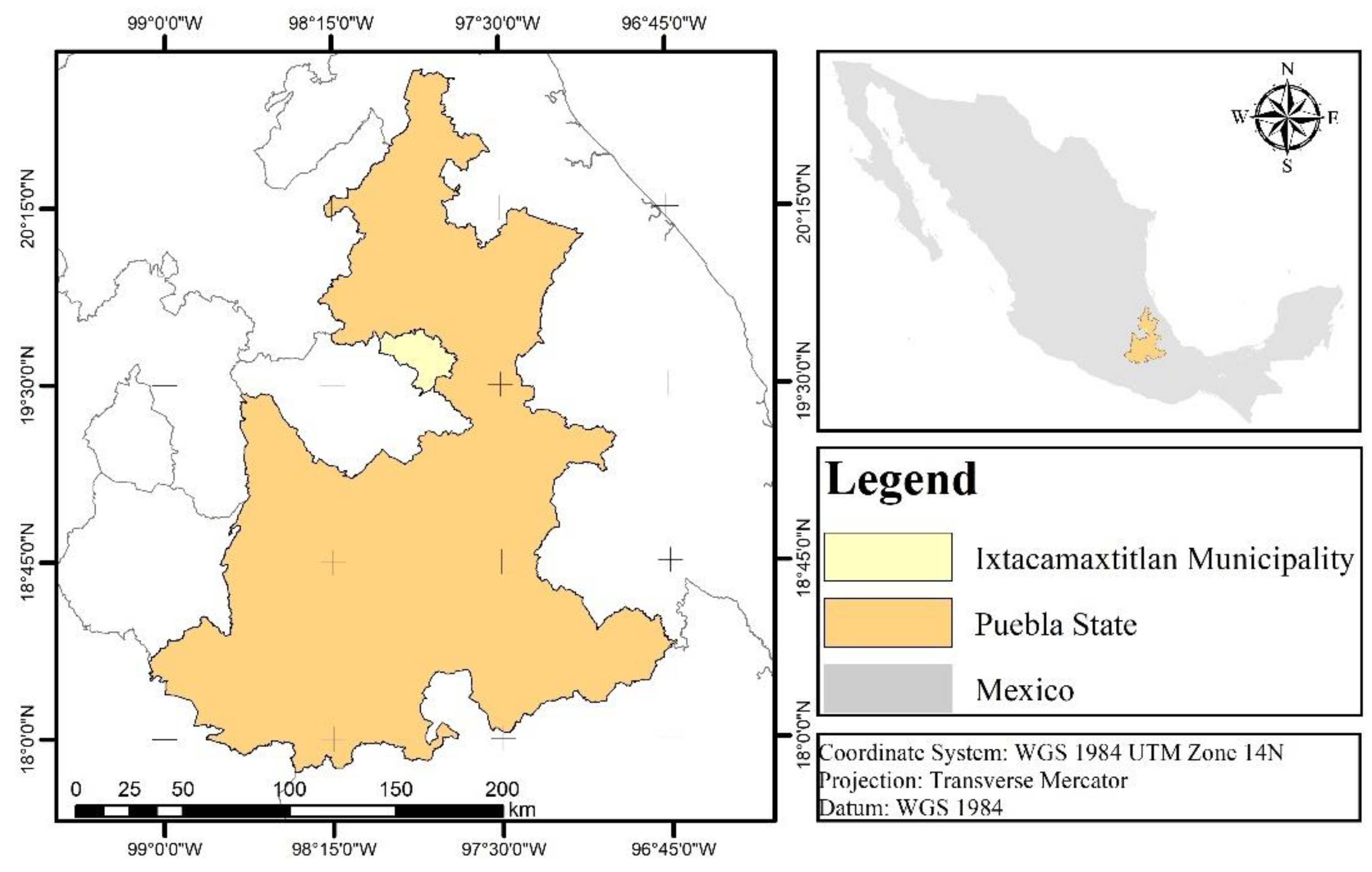
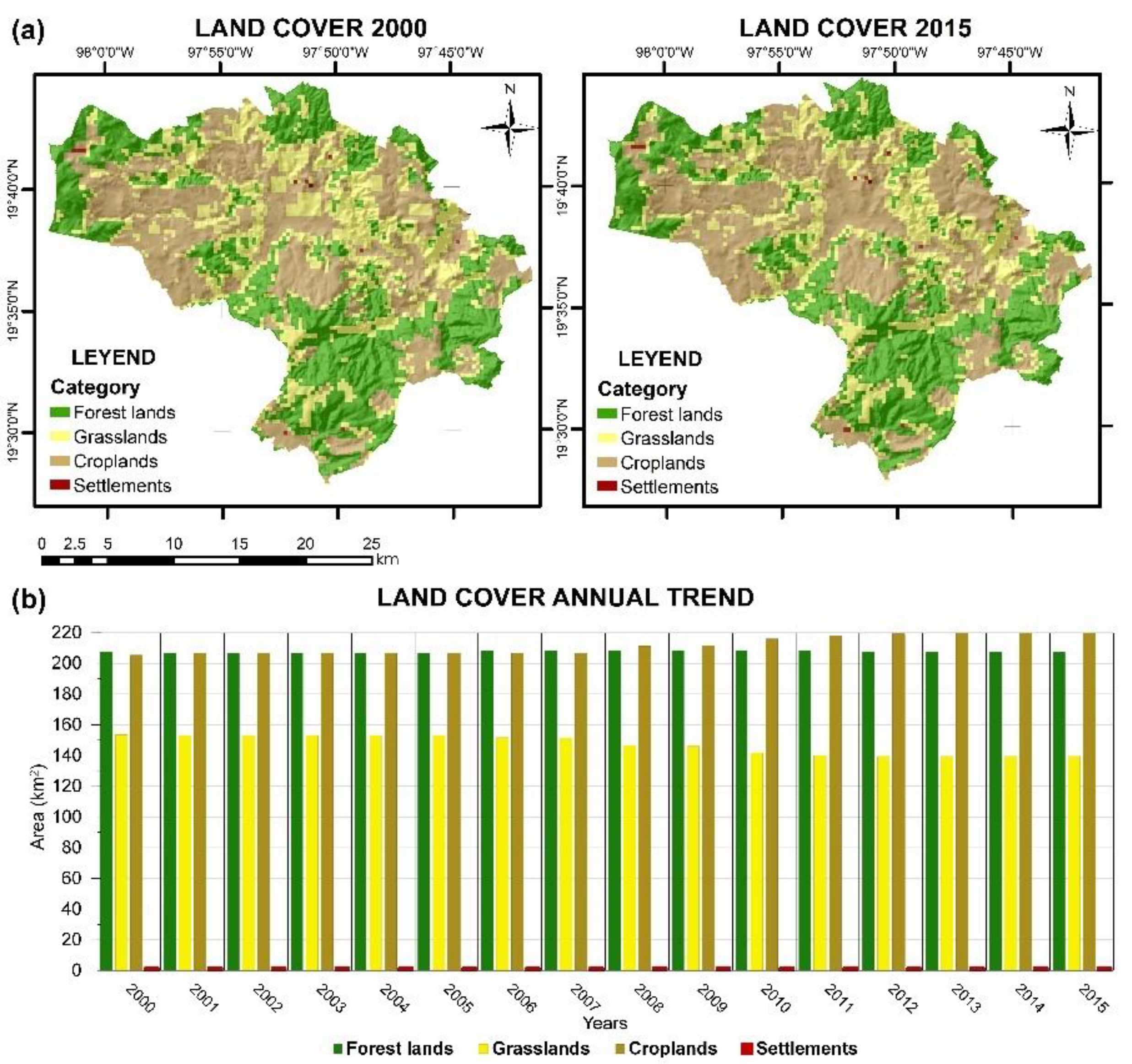

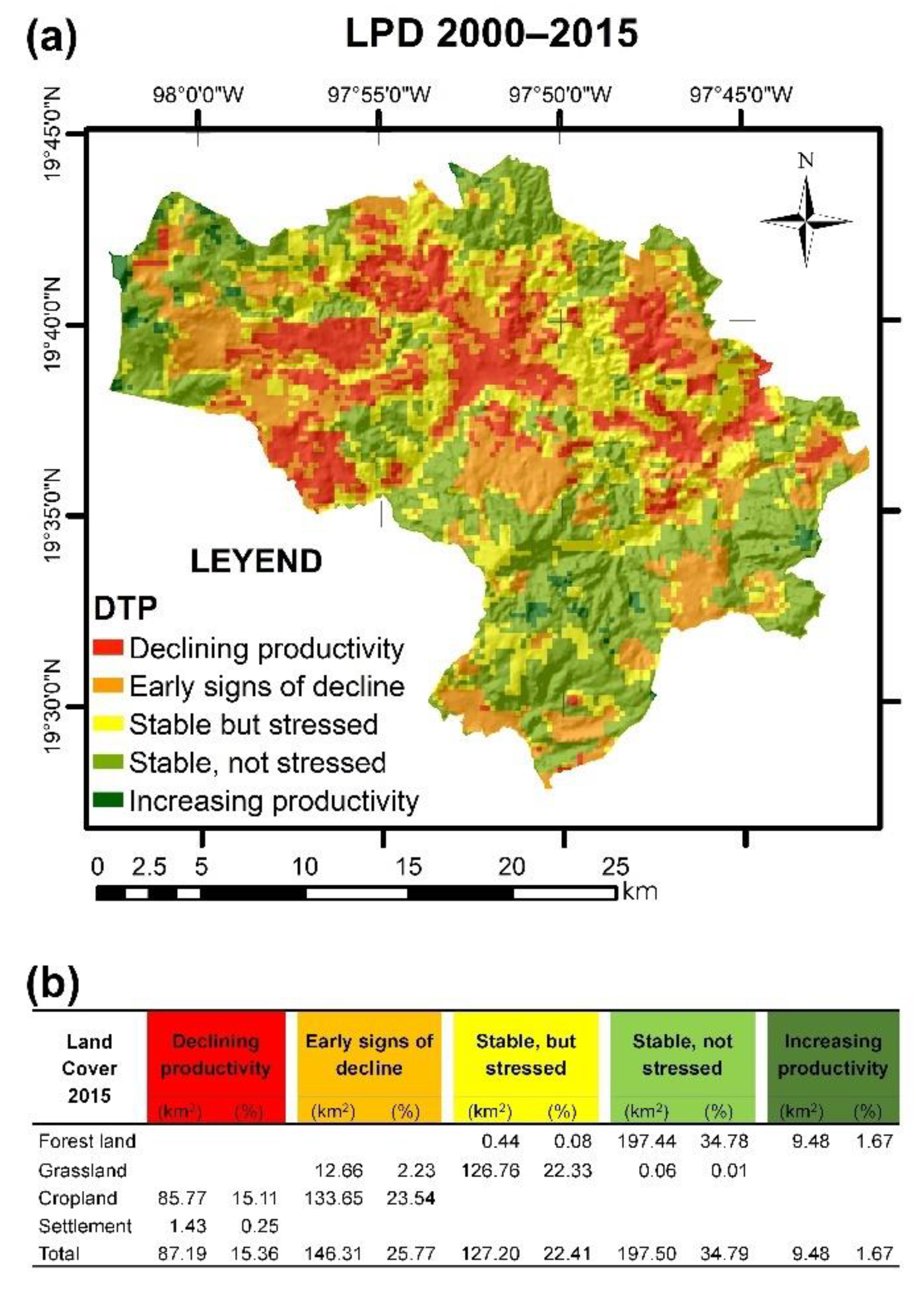
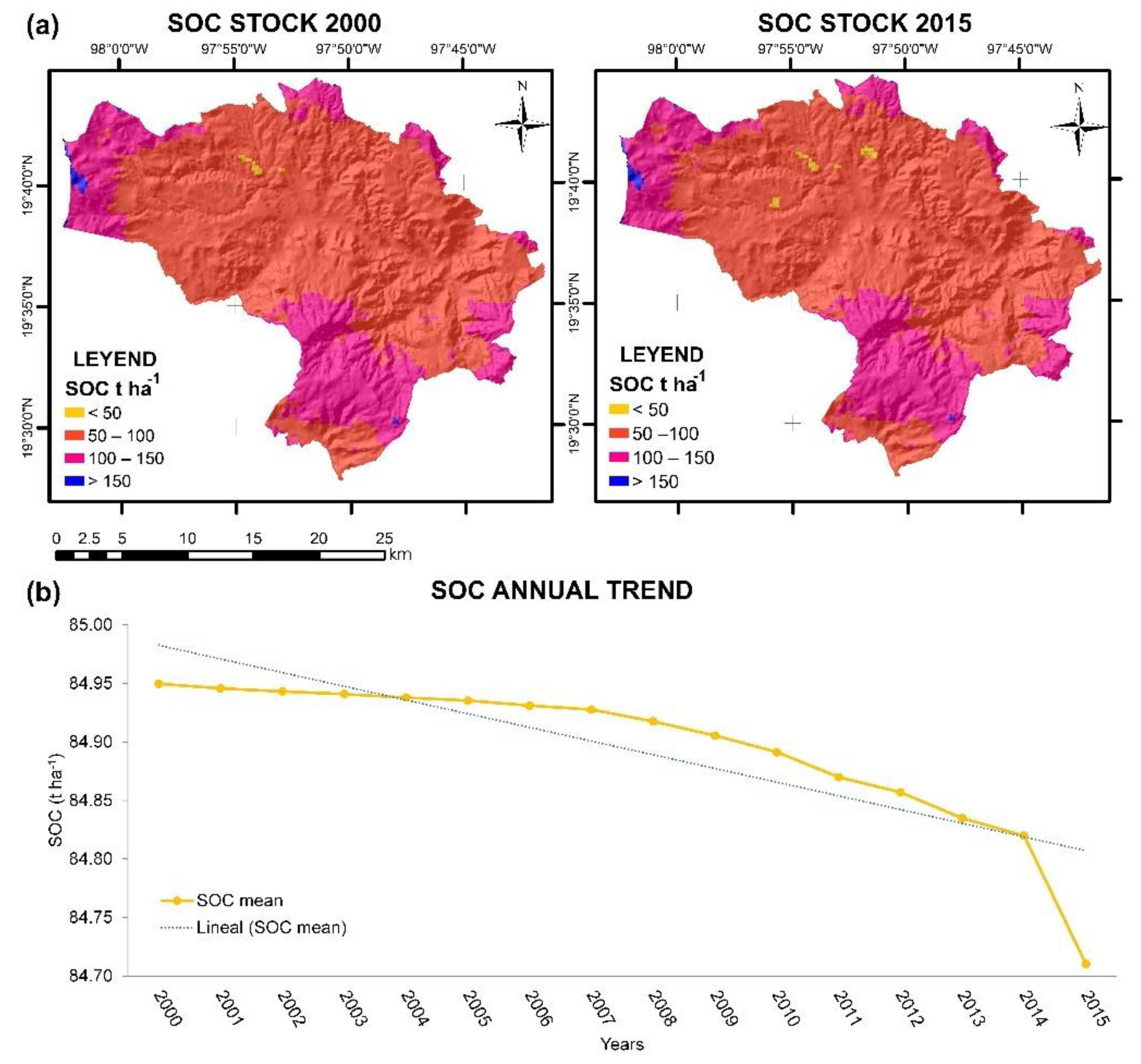
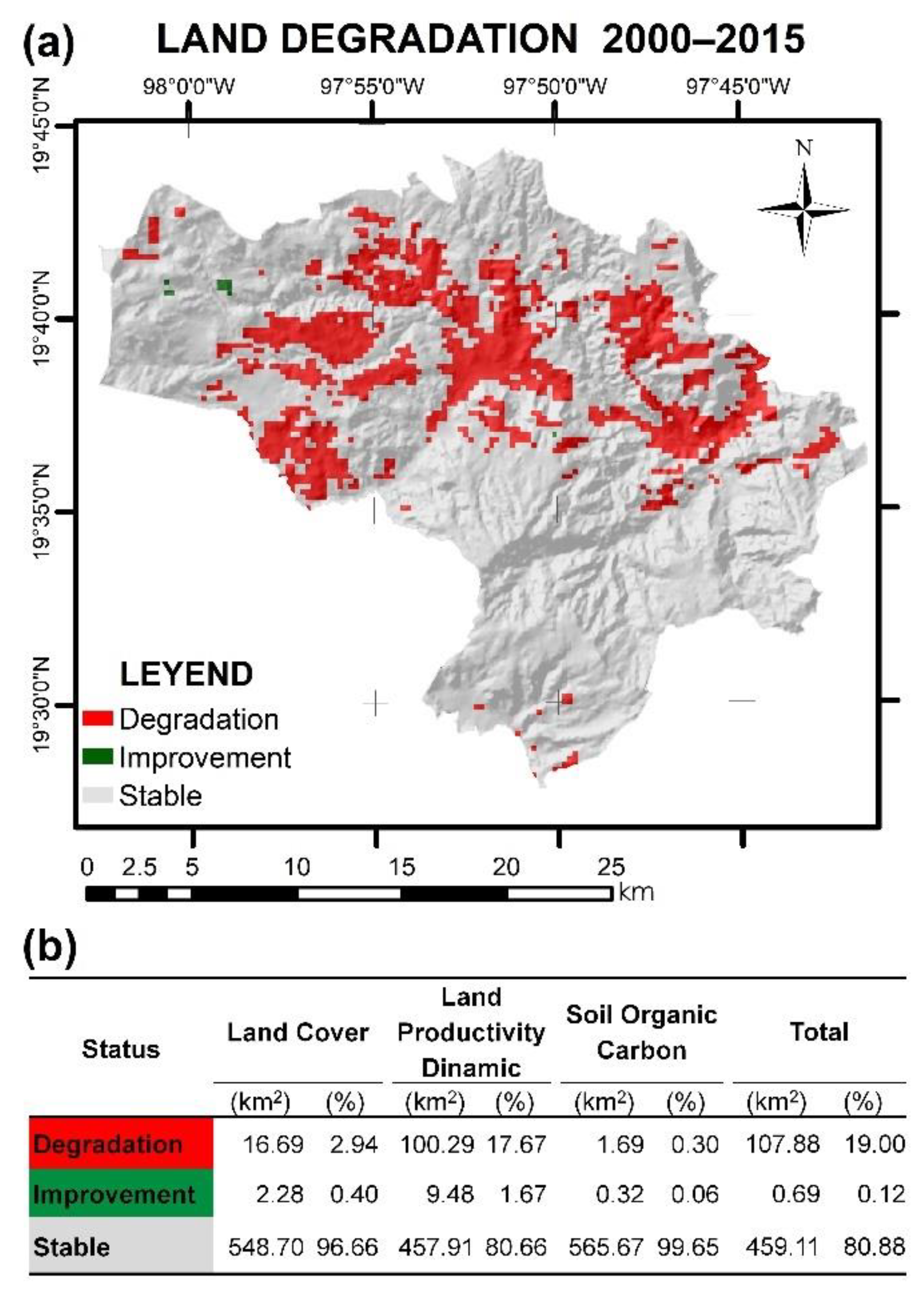
| Code | Categories (UNCCD) | Classification Description (ESA-CCI-LC) |
|---|---|---|
| 1 | Forest lands | Tree cover; broadleaved/needle leaved; evergreen/deciduous; closed to open; 15 to 50% cover. |
| 2 | Grasslands | Mosaic natural vegetation, tree, shrub, herbaceous cover (>50%)/cropland (<50%); scrubland, grassland; lichens and mosses; sparse vegetation, tree, shrub, herbaceous cover (<15%). |
| 3 | Croplands | Cropland, rainfed/irrigated; with/without herbaceous, tree, or shrub cover; or associated with natural vegetation. |
| 4 | Wetlands | Tree cover, flooded, saline water; tree cover, flooded, fresh or brackish water; shrub or herbaceous cover, flooded, fresh/saline/brackish water. |
| 5 | Settlements | Urban areas. |
| 6 | Other lands | Bare areas; permanent snow and ice. |
| 7 | Water bodies | Water bodies. |
| Categories | LC 2000 | LC 2015 | Change | ||
|---|---|---|---|---|---|
| (km2) | (%) | (km2) | (%) | (%) | |
| Forest lands | 207.61 | 36.57 | 207.35 | 36.53 | −0.13 |
| Grasslands | 153.44 | 27.03 | 139.49 | 24.57 | −9.09 |
| Croplands | 205.26 | 36.16 | 219.41 | 38.65 | +6.89 |
| Settlements | 1.36 | 0.24 | 1.42 | 0.25 | +4.41 |
| NDVI | 2000 | 2015 | Change | ||
|---|---|---|---|---|---|
| (km2) | (%) | (km2) | (%) | (%) | |
| Very weak | 253.15 | 44.59 | 97.16 | 17.11 | -61.61 |
| Weak | 282.31 | 49.73 | 311.21 | 54.82 | +10.23 |
| Moderate | 32.22 | 5.67 | 150.34 | 26.48 | +366.85 |
| Intensive | 0 | 0 | 8.98 | 1.58 | +100.00 |
| Land Cover Categories 2000 | Land Cover Categories 2015 | Change | NDVI Class 2015 | Land Productivity Dynamics Class | Trend * | |
|---|---|---|---|---|---|---|
| (km2) | (%) | |||||
| Forest lands | Forest lands | 8.91 | 1.57 | Intensive | Increasing productivity | No Change |
| Grasslands | Grasslands | 0.06 | 0.01 | Intensive | Stable, not stressed | No Change |
| Forest lands | Forest lands | 131.85 | 23.23 | Moderate | Stable, not stressed | No Change |
| Forest lands | Grasslands | 0.06 | 0.01 | Moderate | Stable but stressed | Negative |
| Forest lands | Croplands | 0.25 | 0.04 | Moderate | Early signs of decline | Negative |
| Grasslands | Grasslands | 12.40 | 2.18 | Moderate | Stable but stressed | No Change |
| Grasslands | Forest lands | 0.19 | 0.03 | Moderate | Increasing productivity | Positive |
| Croplands | Croplands | 5.21 | 0.92 | Moderate | Early signs of decline | No Change |
| Croplands | Forest lands | 0.38 | 0.07 | Moderate | Increasing productivity | Positive |
| Forest lands | Forest lands | 63.86 | 11.25 | Weak | Stable, not stressed | No Change |
| Forest lands | Grasslands | 0.99 | 0.17 | Weak | Early signs of decline | Negative |
| Forest lands | Croplands | 1.21 | 0.21 | Weak | Declining productivity | Negative |
| Grasslands | Grasslands | 114.30 | 20.13 | Weak | Stable but stressed | No Change |
| Grasslands | Forest lands | 0.73 | 0.13 | Weak | Stable, not stressed | Positive |
| Grasslands | Croplands | 7.21 | 1.27 | Weak | Early signs of decline | Negative |
| Croplands | Croplands | 120.98 | 21.31 | Weak | Early signs of decline | No Change |
| Croplands | Forest lands | 0.99 | 0.17 | Weak | Stable not stressed | Positive |
| Croplands | Settlements | 0.06 | 0.01 | Weak | Declining productivity | Negative |
| Settlements | Settlements | 0.88 | 0.15 | Weak | Declining productivity | No change |
| Forest lands | Forest lands | 0.44 | 0.08 | Very weak | Stable, but stressed | No change |
| Forest lands | Croplands | 0.04 | 0.01 | Very weak | Declining productivity | Negative |
| Grasslands | Grasslands | 11.67 | 2.06 | Very weak | Early signs of decline | No change |
| Grasslands | Croplands | 6.87 | 1.21 | Very weak | Declining productivity | Negative |
| Croplands | Croplands | 77.65 | 13.68 | Very weak | Declining productivity | No change |
| Settlements | Settlements | 0.49 | 0.09 | Very weak | Declining productivity | No change |
| Land Cover | Change Area | SOC Stock 2000 | SOC Stock 2015 | Initial SOC Stocks 2000 | Final SOC Stocks 2015 | Change in SOC Stock | |
|---|---|---|---|---|---|---|---|
| 2000 | 2015 | (km2) | (t ha−1) | (t ha−1) | (tC) * | (tC) * | (tC) * |
| Forest lands | Grasslands | 1.05 | 96.35 | 95.94 | 10,117.06 | 10,073.82 | −43.24 |
| Forest lands | Croplands | 1.49 | 96.87 | 89.35 | 14,433.57 | 13,312.83 | −1120.74 |
| Grasslands | Croplands | 14.09 | 62.69 | 58.50 | 88,330.58 | 82,432.73 | −5897.85 |
| Croplands | Settlements | 0.06 | 80.00 | 79.00 | 504.00 | 479.70 | −6.30 |
| Land Cover Category | Degradation | Stable | Improvement | |||
|---|---|---|---|---|---|---|
| (km2) | (%) * | (km2) | (%) * | (km2) | (%) * | |
| Forest lands | 0.50 | 0.09 | 206.16 | 36.32 | 0.69 | 0.12 |
| Grasslands | 12.72 | 2.24 | 126.76 | 22.33 | 0.00 | 0.00 |
| Croplands | 93.23 | 16.42 | 126.19 | 22.23 | 0.00 | 0.00 |
| Settlements | 1.42 | 0.25 | 0.00 | 0.00 | 0.00 | 0.00 |
Publisher’s Note: MDPI stays neutral with regard to jurisdictional claims in published maps and institutional affiliations. |
© 2022 by the authors. Licensee MDPI, Basel, Switzerland. This article is an open access article distributed under the terms and conditions of the Creative Commons Attribution (CC BY) license (https://creativecommons.org/licenses/by/4.0/).
Share and Cite
Arroyo, I.; Cervantes, V.; Tamaríz-Flores, V.; Castelán, R. Land Degradation Neutrality: State and Trend of Degradation at the Subnational Level in Mexico. Land 2022, 11, 562. https://doi.org/10.3390/land11040562
Arroyo I, Cervantes V, Tamaríz-Flores V, Castelán R. Land Degradation Neutrality: State and Trend of Degradation at the Subnational Level in Mexico. Land. 2022; 11(4):562. https://doi.org/10.3390/land11040562
Chicago/Turabian StyleArroyo, Itzel, Virginia Cervantes, Víctor Tamaríz-Flores, and Rosalía Castelán. 2022. "Land Degradation Neutrality: State and Trend of Degradation at the Subnational Level in Mexico" Land 11, no. 4: 562. https://doi.org/10.3390/land11040562
APA StyleArroyo, I., Cervantes, V., Tamaríz-Flores, V., & Castelán, R. (2022). Land Degradation Neutrality: State and Trend of Degradation at the Subnational Level in Mexico. Land, 11(4), 562. https://doi.org/10.3390/land11040562






